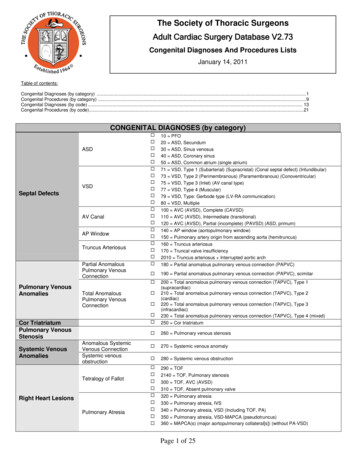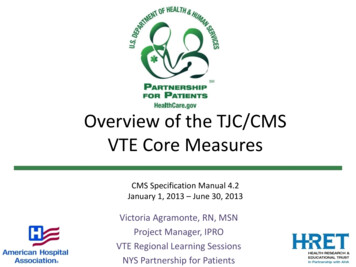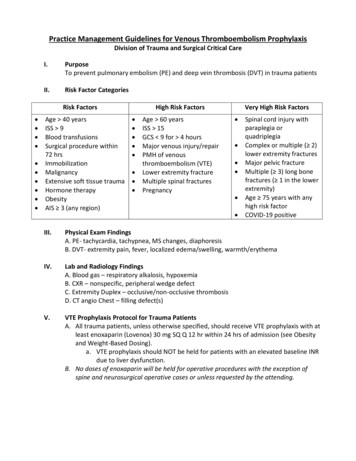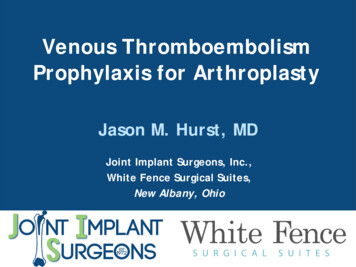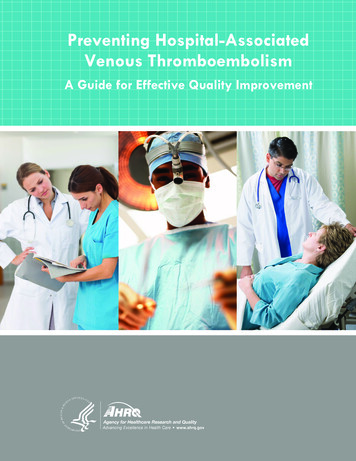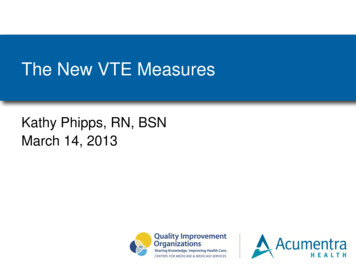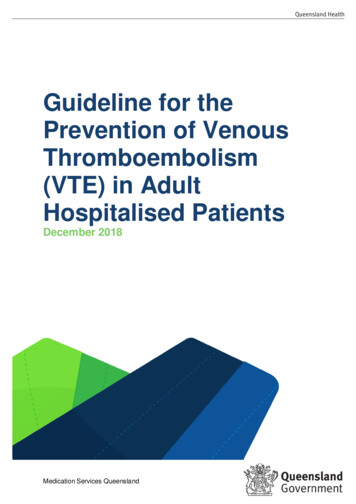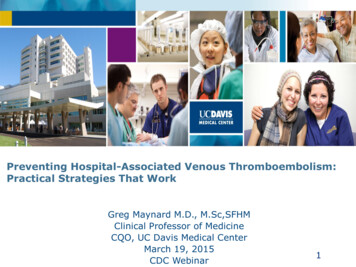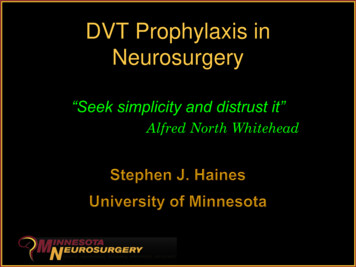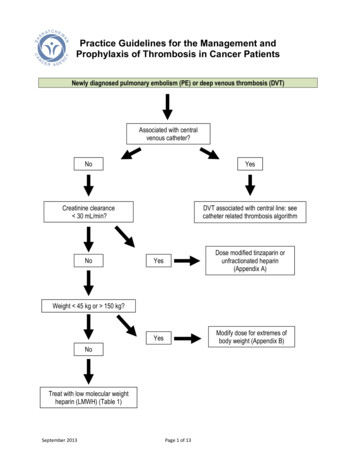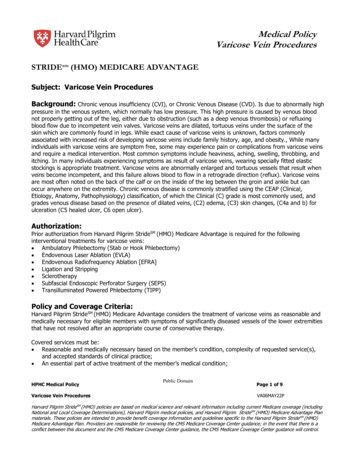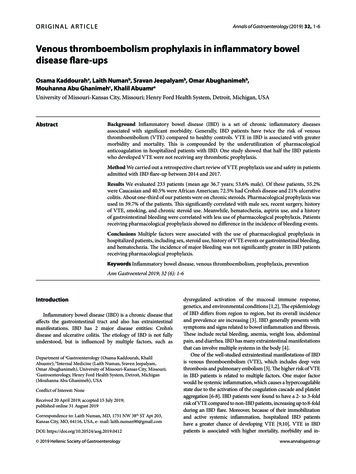
Transcription
ORIGINAL ARTICLEAnnals of Gastroenterology (2019) 32, 1-6Venous thromboembolism prophylaxis in inflammatory boweldisease flare-upsOsama Kaddouraha, Laith Numanb, Sravan Jeepalyamb, Omar Abughanimehb,Mouhanna Abu Ghanimehc, Khalil AbuamraUniversity of Missouri-Kansas City, Missouri; Henry Ford Health System, Detroit, Michigan, USAAbstractBackground Inflammatory bowel disease (IBD) is a set of chronic inflammatory diseasesassociated with significant morbidity. Generally, IBD patients have twice the risk of venousthromboembolism (VTE) compared to healthy controls. VTE in IBD is associated with greatermorbidity and mortality. This is compounded by the underutilization of pharmacologicalanticoagulation in hospitalized patients with IBD. One study showed that half the IBD patientswho developed VTE were not receiving any thrombotic prophylaxis.Method We carried out a retrospective chart review of VTE prophylaxis use and safety in patientsadmitted with IBD flare-up between 2014 and 2017.Results We evaluated 233 patients (mean age 36.7 years; 53.6% male). Of these patients, 55.2%were Caucasian and 40.5% were African American; 72.5% had Crohn’s disease and 21% ulcerativecolitis. About one-third of our patients were on chronic steroids. Pharmacological prophylaxis wasused in 39.7% of the patients. This significantly correlated with male sex, recent surgery, historyof VTE, smoking, and chronic steroid use. Meanwhile, hematochezia, aspirin use, and a historyof gastrointestinal bleeding were correlated with less use of pharmacological prophylaxis. Patientsreceiving pharmacological prophylaxis showed no difference in the incidence of bleeding events.Conclusions Multiple factors were associated with the use of pharmacological prophylaxis inhospitalized patients, including sex, steroid use, history of VTE events or gastrointestinal bleeding,and hematochezia. The incidence of major bleeding was not significantly greater in IBD patientsreceiving pharmacological prophylaxis.Keywords Inflammatory bowel disease, venous thromboembolism, prophylaxis, preventionAnn Gastroenterol 2019; 32 (6): 1-6DOI: https://doi.org/10.20524/aog.2019.0412dysregulated activation of the mucosal immune response,genetics, and environmental conditions [1,2]. The epidemiologyof IBD differs from region to region, but its overall incidenceand prevalence are increasing [3]. IBD generally presents withsymptoms and signs related to bowel inflammation and fibrosis.These include rectal bleeding, anemia, weight loss, abdominalpain, and diarrhea. IBD has many extraintestinal manifestationsthat can involve multiple systems in the body [4].One of the well-studied extraintestinal manifestations of IBDis venous thromboembolism (VTE), which includes deep veinthrombosis and pulmonary embolism [5]. The higher risk of VTEin IBD patients is related to multiple factors. One major factorwould be systemic inflammation, which causes a hypercoagulablestate due to the activation of the coagulation cascade and plateletaggregation [6-8]. IBD patients were found to have a 2- to 3-foldrisk of VTE compared to non-IBD patients, increasing up to 8-foldduring an IBD flare. Moreover, because of their immobilizationand active systemic inflammation, hospitalized IBD patientshave a greater chance of developing VTE [9,10]. VTE in IBDpatients is associated with higher mortality, morbidity and in- 2019 Hellenic Society of Gastroenterology www.annalsgastro.grIntroductionInflammatory bowel disease (IBD) is a chronic disease thataffects the gastrointestinal tract and also has extraintestinalmanifestations. IBD has 2 major disease entities: Crohn’sdisease and ulcerative colitis. The etiology of IBD is not fullyunderstood, but is influenced by multiple factors, such asDepartment of aGastroenterology (Osama Kaddourah, KhalilAbuamr); bInternal Medicine (Laith Numan, Sraven Jeepalyam,Omar Abughanimeh), University of Missouri-Kansas City, Missouri;cGastroenterology, Henry Ford Health System, Detroit, Michigan(Mouhanna Abu Ghanimeh), USAConflict of Interest: NoneReceived 20 April 2019; accepted 15 July 2019;published online 31 August 2019Correspondence to: Laith Numan, MD, 1751 NW 38th ST Apt 203,Kansas City, MO, 64116, USA, e- mail: laith.numan90@gmail.com
2 O. Kaddourah et alhospital cost compared to non-IBD patients [3]. Hospital stay andhospital charges were double in IBD patients who developed VTEcompared to non-VTE IBD patients [11].Given the higher mortality, morbidity, and cost associatedwith VTE in IBD patients, VTE prophylaxis is currentlyrecommended in IBD guidelines [12,13]. Nevertheless, VTEprophylaxis is still underutilized in IBD patients, primarilybecause of the nature of IBD presentation with rectalbleeding [14]. A study showed that half of the IBD patientswho developed VTE were not on any thrombotic prophylaxisat the time [14]. The risk of major bleeding was not found toincrease in IBD patients receiving prophylaxis [15]. In thisstudy, we analyzed the use of VTE prophylaxis in IBD patientspresenting with a flare. In addition, we investigated the safetyof using chemical prophylaxis in these patients and its effect onthe risk of bleeding.Patients and methodsSample selectionWe performed a retrospective chart review of all patientsdiagnosed with any IBD type and were admitted to the TrumanMedical Center because of an IBD flare. Our study included allpatients admitted for a flare-up of the disease during the period2014-2017. Patients with IBD flare-up were identified byreviewing the discharge diagnosis on the discharge summaryafter the workup was concluded. Around 400 patients met ourinitial criteria, from a total of 7230 admissions during the studyperiod. We generated a randomized sample of 233 patients andincluded all of these in our research (Fig. 1).The patients included in the study were all adults above theage of 18 years, non-pregnant, diagnosed with IBD (ulcerativecolitis, Crohn’s disease, or unspecified) via a biopsy and whopresented with IBD flare-up. The exclusion criteria includedpregnancy and age younger than 18 years. Patients who haddeveloped VTE in the 3 months before hospitalization, or werefound to have VTE at presentation, were also excluded, as werethose with a known hereditary risk of thrombosis or bleeding.We utilized direct chart review to collect the data of our233 patients, chosen via random sampling. We includedquantitative data based on laboratory reports, physicians’ notesand imaging reports. A universal datasheet was formulated tocomplete the variables for each patient. All data were collectedfrom the encounter at which the patients presented with a flareof their disease. We also followed patients for up to 30 dayspost-discharge to include data about the outcome. No patientswere excluded, given that our initial list included all thosewho fulfilled our inclusion criteria. All datasheets from allinvestigators were combined into a single sheet before analysis.MeasuresThe primary objectives of our study were to determine: 1)the 30-day incidence of VTE (e.g., deep vein thrombosis andAnnals of Gastroenterology 32 7230 Encounters from2014 - September 2017400 Patients met ourcriteriaExcluded 167 due to missingdata233 Patients/encountersfinal sampleFigure 1 Study flowchartpulmonary embolism) in hospitalized IBD patients whoreceived chemical VTE prophylaxis versus those who receivedno prophylaxis; 2) the incidence of bleeding events, primarilygastrointestinal and intracranial, over 30 days postdischarge, to assess the safety of using chemical prophylaxisin IBD patients admitted for flare-up of their disease. Datafrom the multiple measures were collected to assess ourstudy outcomes. These included data about the patients’demographics, comorbidities, laboratory tests, and diseasedescription.IRB informationIRB #17-316: Venous Thromboembolism (VTE)Prophylaxis in Inflammatory Bowel Disease (IBD) FlareUps – A Retrospective Study. The above-referenced researchwas reviewed by the IRB Chair on October 18, 2017. The IRBconcluded that the study is approved under the expeditedCategory.Statistical analysisData analysis was performed using SPSS software(version 25). Normally distributed continuous variables werereported as means standard deviation (SD), and categoricalvariables were reported as counts and percentages. Chi-squaretests were used to compare categorical variables, and t-test wasused to compare the continuous outcomes. We performed amultivariable logistic regression analysis for the use of VTEchemical prophylaxis. All tests were two-sided with an α levelset at 0.05 for statistical significance.ResultsThe 233 patients included in the study had a mean age of36.7 (range 19-70) years. Of the patients recruited, 125 patients(53.6%) were male and 108 (46.4%) were female. Data aboutrace were collected, which showed that most of our patients were
VTE prophylaxis in IBD flare-ups 3Table 1 Demographics and clinical parameters by VTE risk factorsand IBD statusCharacteristicAge (years)Male sexRaceValue36.7 10.6125/233 (53.6%)Caucasian 55.2%African American 40.5%Hispanic 3.4%Body mass index (kg/m2)25 6.5Smoking status (present)116/233 (49.8%)History of venousthromboembolism (present)5/233 (2.1%)History of gastrointestinalbleeding (present)91/233 (39.1%)Chronic kidneydisease (present)18/233 (7.7%)Intensive care unit stay2/233 (0.9%)Malignancy (present)NullOral contraceptive pilluse (present)8/233 (3.4%)Recent surgery (present)DiagnosisDuration disease (months)Age of onset (A‑class)Location (L‑class)Bowel surgery (present)1/233 (0.4%)CD 169/233 (72.5%) B2UC 49/233 (21%)69 82 16 years (A1): 21/169 (12.4%)17‑40 years (A2): 112/169 (66.3%) 40 years (A3): 36/169 (21.3%)Ileal (L1): 28/169 (16.5%)Colonic (L2): 41/169 (24.1%)Ileocolonic (L3): 97/169 (57.4%)87/233 (37.3%)Chronic steroids (present)71/233 (30.5%)Hematochezia (present)126/233 (54.1%)C‑reactive protein (mg/L)5.6 7.2Erythrocyte sedimentationrate (mm/h)35 27.7White blood cell count(103/μL) Colonicinvolvement11 5.4Colonic involvementcolitis (21%). Upon review of the presentation and biopsyresults, 15 patients were deemed to have an unspecified disease(6.4%). About 20% of our patients were on biologic therapy(i.e., adalimumab, infliximab, vedolizumab). Another 18%were on immunomodulators (i.e., azathioprine), 2% were ona combination therapy of biologics and immunomodulators,while 40% of patients were not on maintenance therapy at thetime of our study.About a third of our patients were taking chronic steroidsat the time of observation. Data regarding previous bowelsurgeries related to disease were collected in approximatelyone third of the patients. Patients with Crohn’s disease werestratified according to the region affected by the disease.Nearly half of the patients had an ileocolonic disease, whereasone-third had colonic disease only. Most of the patients withulcerative colitis had either pan-colonic involvement or leftcolon involvement. One hundred twenty-six patients presentedwith hematochezia (54.1%). About half of the patients hadelevated C-reactive protein (laboratory value above 5) and halfof the patients had leukocytosis on presentation (laboratoryvalue above 12 103/μL).Of the patients admitted our institute with IBD flare-up,39.7% were given chemical prophylaxis over an average durationof 4.4 days. Seventy-seven patients on chemical prophylaxisreceived heparin, while the rest received enoxaparin. Variablescorrelated with VTE prophylaxis use are included in Fig. 2. Theuse of chemical prophylaxis correlated significantly with malesex (odds ratio [OR] 3.4, 95% confidence interval [CI] 3.1-3.6),recent surgery (OR 1.06, 95%CI 1.05-1.07), history of VTE(OR 1.39, 95%CI 1.18-1.65), current smoking (OR 1.18, 95%CI1.1-1.25), current chronic steroid use (OR 1.5, 95%CI 1.471.69), and history of chronic kidney disease (CKD) (OR 1.24,95%CI 1.13-1.366). In contrast, the presence of hematochezia(OR 0.13, 95%CI 0.122-0.14), aspirin use (OR 0.44, 95%CI0.21-0.89), and history of gastrointestinal bleeding (OR 0.501,95%CI 0.46-0.54) showed a significant negative correlationwith the use of chemical prophylaxis. Patients receivingchemical prophylaxis had lower odds of overall bleedingevents (OR 0.192, 95%CI 0.141-0.263; P 0.001), and there wasnot any significant difference in hemoglobin levels comparedto patients not on chemical prophylaxis (P 0.64); there wasno significant correlation between the hemoglobin value atpresentation and the initiation of chemical VTE prophylaxis,nor any correlation with the severity of the disease.Left‑sided 30/49 (61.2%)Pancolitis 17/49 (34.6%)DiscussionCaucasian (128, 55.2% of the population), while 94 patientswere African American (40.5%), and a small proportion wereHispanic or Asian (3.4% and 0.4%, respectively). About half ofour sample were smokers (116, 49.8%). The mean body massindex of the patients was 25. Further information about thepatient population and the disease characteristics is shown inTable 1.Most of our patients were diagnosed with Crohn’s disease(72.5%), while 49 patients were diagnosed with ulcerativeWe recruited patients into our study retrospectively, usinga database of patients admitted for IBD flare-up. The patientswere relatively young, with a mean age of around 37 years old.This mean age is close to the age groups we see in the IBD clinicat our hospital, with outliers seen in the elderly, while we donot treat patients younger than 18 years of age. The averageduration of the disease is around 2 years, which makes theaverage age of diagnosis around 35 years old in our sample.This age distribution is believed to represent the population ofAnnals of Gastroenterology 32
4 O. Kaddourah et al00.511.522.533.5414GenderICU stay12Recent surgeryChronicsteroids10OCP useSmoking statusHx VTE86Hx GI bleedingHematochezia4CKDASA use2Abd surgery0Figure 2 Variables correlated with the use of VTE prophylaxis in IBD patientsICU, intensive care unit; OCP, oral contraceptive pill; VTE, venous thromboembolism; GI, gastrointestinal; CKD, chronic kidney disease;ASA, aspirin; Abd, abdominalpatients admitted for IBD flare-up in our hospital, given thesize of the sample and randomized sampling. Although mostof the patients included were Caucasian and of male sex, thispredominance is not thought to be significant.In regard to risk factors for VTE in IBD patients, smoking isa common risk and it is discouraged in patients with IBD. Weroutinely counsel IBD patients on tobacco use, as we believe itcan increase the risk of exacerbation. Around half of our samplewere smokers. The analysis of data based on smoking statusshowed that smokers have higher odds to receive chemicalprophylaxis for VTE (OR 1.18, 95%CI 1.1-1.25). This couldbe related to smoking status per se, where physicians becomemore concerned about the risk of VTE and initiate prophylaxis.Alternatively, it could be associated with the medical conditionof patients with positive smoking status, who might have morecomorbidities and more cardiac risk factors that alter thedecision regarding VTE prophylaxis. Our observations do notindicate that smoking decreases the risk of hematochezia uponpresentation, nor that it decreases the overall gastrointestinalbleeding risk.Our sample consisted mainly of young patients who hadfrequent admissions for IBD flare-ups. This trend in age isgenerally seen in our institute, with the disease affecting youngpatients more and having equal distribution between the sexes.Given their young age, many patients have no concurrentcomorbidities and are not taking multiple medicationsregularly. Half of our sample were smokers, which puts them atincreased risk of disease progression and recurrence. Crohn’sdisease was dominant in our population, featuring in morethan 70% of the cases. Imaging studies with evidence of extracolonic involvement and known IBD may be sufficient todiagnose Crohn’s disease, which might make diagnosis morestraightforward in such cases. Patients with Crohn’s diseasemay have complications related to strictures and fistulization,which forces them to attend hospital and be admitted. ThisAnnals of Gastroenterology 32 could explain, in part, why many of the patients included in ourstudy had Crohn’s disease. This distribution could have affectedour external validity, with only 21% of the sample diagnosedwith ulcerative colitis, especially given that ulcerative colitisis more closely associated with hematochezia and exclusivelyaffects the colon.One of the other risks for VTE is the chronic use ofcorticosteroids, which we defined as current use of variousdoses of corticosteroids at the time of admission for flare-up(one third of our patients). This could be related to a recentflare-up of disease or uncontrolled disease on maintenancetherapy. We included those patients, since they are at increasedrisk for thrombotic events due to steroid use. In a metaanalysis, Sarlos et al found that the use of steroids in IBDpatients was significantly associated with a higher risk ofVTE when compared with IBD patients not on steroids [16].Those findings certainly made physicians more liberal andcomfortable with the use of chemical prophylaxis in suchpatients, given their higher risk. Our results support this, as wefound a higher rate of chemical prophylaxis use in individualson chronic steroids (OR 1.5, 95%CI 1.47-1.69). We also foundthat patients with a history of VTE were more likely to receiveVTE chemical prophylaxis (OR 1.39, 95%CI 1.18-1.65).Physicians taking care of such patients probably perceivedthe increased risk of recurrent VTE in patients with a positivehistory. This was confirmed in multiple studies showing that ahistory of VTE is a risk factor for recurrent VTE [17]. However,we also know that IBD status independently increases the riskof VTE, and that all patients should be on VTE prophylaxisregardless of the status of previous VTE.We also found that CKD is one of the diseases that placesthe patient at higher risk of developing VTE, although thestage of CKD was not specified [18]. There are no specificdata concerning IBD patients with CKD. In our study, havingCKD was associated with an increased use of VTE chemical
VTE prophylaxis in IBD flare-ups 5prophylaxis, which can be explained by the independentincrease of VTE risk in those patients (OR 1.24, 95%CI 1.131.366). Another risk of developing VTE is having undergonerecent surgery, especially high-risk orthopedic surgeries.However, even low-risk operations were associated with asmall increase in VTE risk [17]. This increased risk is usuallyaddressed by putting these patients on prophylaxis, despitetheir other risk factors. IBD patients are already at higher riskof VTE, elevated by recent surgery. We found that patientswho had a history of recent surgery are more likely to receivechemical prophylaxis, given the higher risk mentioned above(OR 1.06, 95%CI 1.05-1.07).On the other hand, we found that patients on low-doseaspirin at home before the presentation are less likely to receivechemical VTE prophylaxis (OR 0.44, 95%CI 0.217-0.893). Thiscan be attributed to the perceived increased risk of bleedingdue to the use of aspirin, which inhibits platelet activation andaggregation by inhibiting the cyclooxygenase enzyme. This, intheory, prevents clotting and can increase the risk of bleeding.Physicians might be more hesitant to initiate VTE prophylaxisin patients with such an increased risk of bleeding, confirmedin our study. There was no significant correlation betweenaspirin use and a drop in hemoglobin level during admission,regardless of the status of VTE prophylaxis.Interestingly, the use of oral contraceptives in ourpatients made it less likely for them to receive VTE chemicalprophylaxis (OR 0.212, 95%CI 0.171-0.265). Oral contraceptiveuse (especially estrogen formulas) is a known risk factor forVTE [18]. Failure to provide VTE chemical prophylaxisto such patients with multiple risk factors places them atincreased risk of VTE. We cannot explain such results, whichcould easily be confounded by other variables since we didnot conduct stratified analysis of the use of oral contraceptivepills in our study. In addition, patients with a history ofabdominal surgeries related to IBD were less likely to receiveVTE prophylaxis, which we could not attribute directly to aspecific factor. One theory would be that physicians perceivepatients with a history of abdominal surgery to be “cured” ofIBD, or at least to have less inflammatory burden after surgery.As mentioned above, inflammatory burden correlates with therisk of VTE. This theory, however, is at odds with the fact thatour patients presented with flare-ups of their inflammation,which puts them at risk of VTE. This is regardless of anytherapeutic measures, including previous surgeries performed.Curative surgeries such as colectomy (elective and emergent)for ulcerative colitis patients were also found to increase therisk of VTE after surgery, regardless of disease status [19].Our results confirm the report by Dwyer et al of theunderutilization of VTE prophylaxis in IBD patients [14]. Inour institute, we found that the utilization of VTE prophylaxiswas only 39.7%. Other studies showed variable rates ofVTE prophylaxis use in their institutes. These rates are stillsuboptimal, ranging from 25-80% of IBD patients admitted forvarious reasons [15,20,21].Most IBD patients present with bloody diarrhea at the time ofthe flare, which makes it challenging for the admitting physicianto start them on pharmacological VTE prophylaxis, given thehigh risk of bleeding. However, a study by Ra et al, which assessedthe safety of VTE prophylaxis in IBD patients, found that thebleeding risk with VTE prophylaxis is not higher than in itsabsence [15]. Our results showed that the use of VTE prophylaxisis safe, and the drop in hemoglobin level over the admissionperiod was not different from the decline noted in patients noton prophylaxis. The underutilization of VTE prophylaxis inour institute encouraged us to follow this study with a qualityimprovement project to improve the rate of VTE prophylaxis.The increased mortality and morbidity in IBD patients whodevelop VTE was the trigger for our study, as we were exploringthe utilization of VTE prophylaxis in our institute and trying toprevent a complication that can be easily avoided by adherenceto VTE prophylaxis. Nguyen et al described the detrimentaleffect of VTE on IBD patients’ mortality and morbiditycompared to non-IBD patients [10]. They found that VTE inhospitalized IBD patients leads to more than 2-fold greatermortality when compared to hospitalized non-IBD patients,with the results adjusted for age and comorbidities. Moreover,they reported an estimated 17% annual rise in VTE among IBDadmissions. These findings make it clear that action should betaken as soon as possible to attempt to prevent this inclementrise of VTE in IBD patients.Limitations of this study were that it was single-centerretrospective and that the characteristics of our patientpopulation were not matched. Also, more than 72% ofour population were diagnosed with Crohn’s disease. Webelieve that our findings might not apply to the generalpopulation, but they reflect a general trend in US hospitalsfor the underutilization of VTE prophylaxis for IBD patients.Multicenter prospective studies on a large sample might helpconfirm these findings and generalize them to all types of IBD.Unfortunately, we could not capture enough VTE events postdischarge to include in our analysis regarding our primaryoutcome. This might be due to the relatively short follow upperiod (30 days post discharge) or losing patients to follow up,given that this was a retrospective data collection.In conclusion, our findings prove that insufficientprogress has been made in terms of implementing the IBDguidelines regarding VTE prophylaxis in hospitalized IBDpatients. We found multiple factors associated with the use ofpharmacological prophylaxis in hospitalized patients, includingsex, steroid use, history of VTE events, and gastrointestinalbleeding. In line with the results of previous studies, we found noincrease in the risk of bleeding in IBD patients using chemicalprophylaxis during flare-ups. Despite the documented safety ofVTE prophylaxis, the risk of bleeding still plays a major role inlimiting the use of VTE prophylaxis, although we have to keepin mind that a balance should be struck between the benefitsand risks. Based on the findings from our study and previousresearch, it is clear that the benefit of preventing VTE in IBDpatients outweighs the risk of bleeding from VTE prophylaxis.AcknowledgmentWe are grateful for the research staff at UMKC who helpedus complete this studyAnnals of Gastroenterology 32
6 O. Kaddourah et alSummary BoxWhat is already known: Patients with inflammatory bowel disease(IBD) are at a higher risk of developing venousthromboembolism (VTE) due to systemicinflammation VTE in IBD patients is associated with highermortality and morbidity VTE prophylaxis is recommended in the guidelinesfor IBD patients VTE prophylaxis is underutilized in hospitalizedIBD patients admitted for various reasonsWhat the new findings are: Found variables that could affect the decisionmaking of admitting physicians in ordering VTEprophylaxis for IBD patents. These variables predict a high risk for thromboticevents, including previous VTE, previoussurgeries, obesity, smoking and chronic steroids.Others predict a high risk for bleeding, includinganticoagulation, antiplatelet medications and ahistory of bleeding events The underutilization of VTE prophylaxis is not anew finding, but this study found that it is still anongoing issue, despite all the published guidelinesReferences1. Podolsky DK. Inflammatory bowel disease. N Engl J Med2002;347:417-429.2. Orholm M, Munkholm P, Langholz E, Nielsen OH, Sørensen TI,Binder V. Familial occurrence of inflammatory bowel disease.N Engl J Med 1991;324:84-88.3. Molodecky NA, Soon IS, Rabi DM, et al. Increasing incidence andprevalence of the inflammatory bowel diseases with time, based onsystematic review. Gastroenterology 2012;142:46-54.4. Olpin JD, Sjoberg BP, Stilwill SE, Jensen LE, Rezvani M,Shaaban AM. Beyond the bowel: extraintestinal manifestations ofinflammatory bowel disease. Radiographics 2017;37:1135-1160.5. Solem CA, Loftus EV, Tremaine WJ, Sandborn WJ. Venousthromboembolism in inflammatory bowel disease. Am JGastroenterol 2004;99:97-101.Annals of Gastroenterology 32 6. Saibeni S, Saladino V, Chantarangkul V, et al. Increased thrombingeneration in inflammatory bowel diseases. Thromb Res2010;125:278-282.7. Collins CE, Cahill MR, Newland AC, Rampton DS. Plateletscirculate in an activated state in inflammatory bowel disease.Gastroenterology 1994;106:840-845.8. Gris JC, Schved JF, Raffanel C, et al. Impaired fibrinolytic capacityin patients with inflammatory bowel disease. Thromb Haemost1990;63:472-475.9. Wallaert JB, De Martino RR, Marsicovetere PS, et al. Venousthromboembolism after surgery for inflammatory bowel disease:are there modifiable risk factors? Data from ACS NSQIP. Dis ColonRectum 2012;55:1138-1144.10. Nguyen GC, Sam J. Rising prevalence of venous thromboembolismand its impact on mortality among hospitalized inflammatorybowel disease patients. Am J Gastroenterol 2008;103:2272-2280.11. Yuhara H, Steinmaus C, Corley D, et al. Meta-analysis: the risk ofvenous thromboembolism in patients with inflammatory boweldisease. Aliment Pharmacol Ther 2013;37:953-962.12. Travis SP, Stange EF, Lémann M, et al; European Crohn’s and ColitisOrganisation (ECCO). European evidence-based Consensuson the management of ulcerative colitis: Current management.J Crohns Colitis 2008;2:24-62.13. Van Assche G, Dignass A, Reinisch W, et al; European Crohn’s andColitis Organisation (ECCO). The second European evidencebased Consensus on the diagnosis and management of Crohn’sdisease: Special situations. J Crohns Colitis 2010;4:63-101.14. Dwyer JP, Javed A, Hair CS, Moore GT. Venous thromboembolismand underutilisation of anticoagulant thromboprophylaxis inhospitalised patients with inflammatory bowel disease. Intern MedJ 2014;44:779-784.15. Ra G, Thanabalan R, Ratneswaran S, Nguyen GC. Predictorsand safety of venous thromboembolism prophylaxis amonghospitalized inflammatory bowel disease patients. J Crohns Colitis2013;7:e479-e485.16. Sarlos P, Szemes K, Hegyi P, et al. Steroid but not biological therapyelevates the risk of venous thromboembolic events in inflammatorybowel disease: a meta-analysis. J Crohns Colitis 2018;12:489-498.17. Heit JA. Risk factors for venous thromboembolism. Clin Chest Med2003;24:1-12.18. Dobrowolski C, Clark EG, Sood MM. Venous thromboembolism inchronic kidney disease: epidemiology, the role of proteinuria, CKDseverity and therapeutics. J Thromb Thrombolysis 2017;43:241-247.19. Kaplan GG, Lim A, Seow CH, et al. Colectomy is a risk factorfor venous thromboembolism in ulcerative colitis. World JGastroenterol 2015;21:1251-1260.20. Mathers B, Williams E, Bedi G, Messaris E, Tinsley A. AnElectronic alert system is associated with a significant increasein pharmacologic venous thromboembolism prophylaxis ratesamong hospitalized inflammatory bowel disease patients. J HealthcQual 2017;39:307-314.21. Tinsley A, Naymagon S, Enomoto LM, Hollenbeak CS, Sands BE,Ullman TA. Rates of pharmacologic venous thromboembolismprophylaxis in hospitalized patients with active ulcerative colitis:results from a tertiary care center. J Crohns Colitis 2013;7:e635-e640.
39.7% were given chemical prophylaxis over an average duration of 4.4 days. Seventy-seven patients on chemical prophylaxis received heparin, while the rest received enoxaparin. Variables correlated with VTE prophylaxis use are included in Fig. 2. The use of chemical prophylaxis correlated significantly with male
